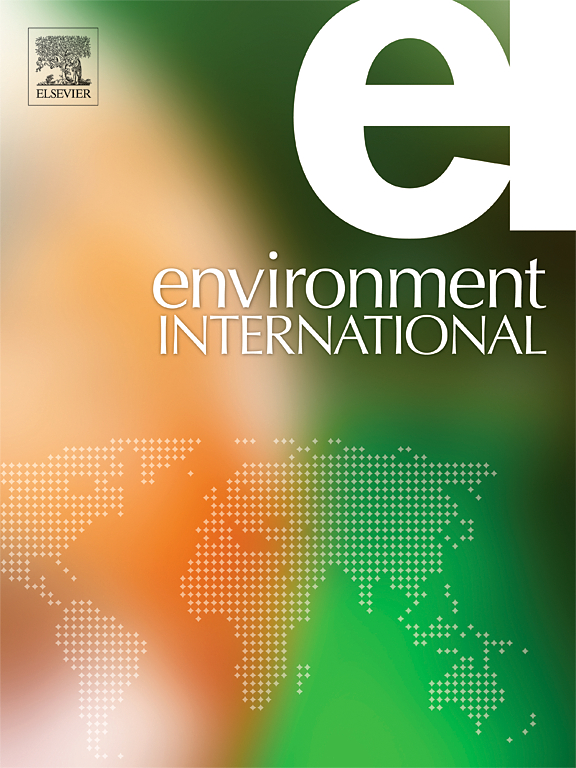急性黄曲霉中毒的发病率和死亡率:一项系统综述
IF 10.3
1区 环境科学与生态学
Q1 ENVIRONMENTAL SCIENCES
引用次数: 0
摘要
黄曲霉毒素是由食品和饲料作物中的曲霉真菌产生的真菌毒素。急性暴露于高水平黄曲霉毒素B1(毒性最强的真菌毒素之一)可导致严重中毒,定义为急性黄曲霉毒素中毒,表现为急性肝功能衰竭,严重时死亡。与慢性接触负担估计相比,目前缺乏对急性黄曲霉毒素中毒的全球负担估计,这使得在预防和控制黄曲霉毒素接触方面难以实施和确定风险管理战略的优先次序。目的本系统综述评估了1990 - 2023年急性黄曲霉毒素中毒发病率和死亡率的全球证据。而症状学&;还检查了疾病持续时间,它作为提供额外临床背景的次要结局。在PubMed、Web of Science、Embase、Scopus、INASP和灰色文献中进行结构化检索。将研究导入到covid中进行审查。研究选择和摘录两名独立的审稿人筛选和摘录标题、摘要和全文。符合条件的研究包括所有的人体研究。结果共纳入11,539篇文献,9篇研究。研究设计、地区、人群年龄和黄曲霉毒素分析均存在异质性。病例数从1例到317例不等,黄曲霉毒素浓度变化很大,即食物中的黄曲霉毒素浓度在10至51100微克/公斤之间,血清中的白蛋白浓度在36至209000微克/毫克之间,组织中的黄曲霉毒素浓度在19至18521微克/克之间。只有一次爆发提供了足够的数据来估计每10万人中有8例的发病率。死亡率从16.2%到76.5%不等,对15岁以下儿童和40岁以上成年人的影响最为严重。常见症状包括呕吐(77% - 100%)、黄疸(88 - 100%)和腹痛(8 - 87%)。偏倚的风险一般较低。本综述显示,急性黄曲霉毒素中毒仍然是一个重大的公共卫生负担,特别是在非洲国家的弱势群体中,尽管研究的可变性和缺乏标准化报告使得负担估计变得困难,强调需要更好的预警系统和标准化报告,尽管受影响地区的基础设施和资源存在挑战。本文章由计算机程序翻译,如有差异,请以英文原文为准。
Incidence and mortality of acute aflatoxicosis: A systematic review
Background
Aflatoxins are mycotoxins produced by Aspergillus fungi in crops intended for food and feed. Acute exposure to high levels of aflatoxin B1, one of the most toxic mycotoxins, can result in severe poisoning, defined as acute aflatoxicosis, which manifests as acute hepatic failure followed by death in severe cases. Currently global burden estimates of acute aflatoxicosis are lacking – in contrast to burden estimates of chronic exposure – making it difficult to implement and prioritize risk management strategies in the prevention and control of aflatoxin exposure.
Aim
This systematic review assessed global evidence on the incidence and mortality of acute aflatoxicosis from 1990 to 2023. While symptomology & disease duration was also examined, it served as a secondary outcome to provide additional clinical context.
Search Strategy and Eligibility
A structured search was conducted in PubMed, Web of Science, Embase, Scopus, INASP and grey literature. Studies were imported into Covidence for review.
Study Selection and Extraction
Two independent reviewers screened and extracted titles, abstracts, and full texts. Eligible studies included all human studies.
Results
From 11,539 references, 9 studies were included. Heterogeneity existed in study design, region, age of the study population and aflatoxin analysis. Number of cases ranged from 1 to 317, with aflatoxin concentrations varying widely, i.e. between 10 and 51,100 µg/kg in food, 36 and 209,000 pg/mg albumin in serum, and 19 and 18,521 pg/g in tissue. Only one outbreak provided sufficient data to estimate an attack rate of 8 cases per 100,000. Mortality ranged from 16.2 to 76.5 %, affecting children under 15 and adults over 40 most severely. Common symptoms included vomiting (77–100 %), jaundice (88–100 %), and abdominal pain (8–87 %). The risk of bias was generally low.
Conclusion
This review shows that acute aflatoxicosis remains a significant public health burden, especially among vulnerable groups in African countries, although the variability in studies and lack of standardized reporting make burden estimation difficult, highlighting the need for better warning systems and standardized reporting, despite challenges with infrastructure and resources in affected areas.
求助全文
通过发布文献求助,成功后即可免费获取论文全文。
去求助
来源期刊

Environment International
环境科学-环境科学
CiteScore
21.90
自引率
3.40%
发文量
734
审稿时长
2.8 months
期刊介绍:
Environmental Health publishes manuscripts focusing on critical aspects of environmental and occupational medicine, including studies in toxicology and epidemiology, to illuminate the human health implications of exposure to environmental hazards. The journal adopts an open-access model and practices open peer review.
It caters to scientists and practitioners across all environmental science domains, directly or indirectly impacting human health and well-being. With a commitment to enhancing the prevention of environmentally-related health risks, Environmental Health serves as a public health journal for the community and scientists engaged in matters of public health significance concerning the environment.
 求助内容:
求助内容: 应助结果提醒方式:
应助结果提醒方式:


